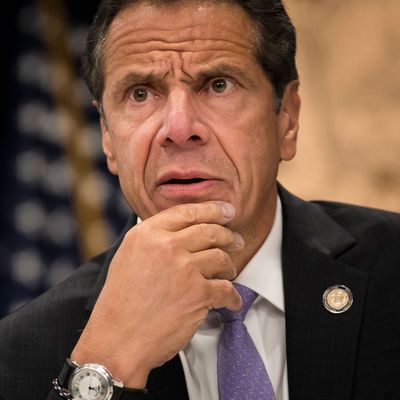
In 2004, Anthony Kennedy suggested that he was open to declaring extreme partisan gerrymanders unconstitutional, if someone could show him a clear, impartial standard for identifying them.
Liberal lawyers and data scientists spent the ensuing decade trying to meet the justice’s challenge. In the meantime, the Republican Party’s landslide victory in the 2010 midterms, advances in map-drawing technology, and deepening polarization along lines of race and population density drastically increased the peril that partisan gerrymanders posed to representative democracy in the United States. When new district lines were drawn to comport with the 2010 Census, the GOP enjoyed full control of 21 state governments. Exploiting advances in data science, and the Democratic coalition’s concentration in urban areas, Republicans were able to draw historically biased election maps, thereby entrenching their newfound power from popular rebuke — even in “purple states” like Wisconsin, where it is now all but impossible for Democrats to gain control of the state legislature.
All this made partisan gerrymandering a bigger problem for Democrats than Republicans. And that fact made partisan gerrymandering an even bigger problem for our democracy: So long as there was ambiguity about which party derived the most benefit from the practice, there was some hope for mutual restraint, if not for making nonpartisan redistricting a universal rule. After the tea-party wave, it became difficult to see why Republicans would ever consent to universally eliminating partisan gerrymanders, whether through an interstate compact or federal legislation. The Supreme Court became reformers’ best hope.
Then Anthony Kennedy’s retirement diminished that hope. And on Thursday, the court’s conservative majority extinguished it, ruling that federal courts have no role in blocking extreme partisan gerrymanders.
Reformers have made some progress on the state level in recent years, including in a couple of Republican-controlled states. But the cause of fair districting — and the principle of equal representation — has more purchase among liberals than it does among conservatives. And blue states have proven more receptive to adopting nonpartisan redistricting.
This raises a vexing question about how Democrats (and/or small-d democrats) should proceed on the issue: Should they continue pushing for fair districting wherever they have power, or would such efforts actually make federal representation even more inequitable? After all, if blue states forfeit their power to gerrymander, while red states do not, then Congress’s historic bias in favor of the GOP will deepen.
Given this reality, might it be more constructive to fight fire with fire — which is to say, to draw shamelessly pro-Democratic maps wherever the party has power, so as to simultaneously rebalance federal representation, and give Republicans greater incentive to reach a bipartisan agreement in favor of universal nonpartisan districting? Democrats currently have control over 14 state governments. With a strong showing in 2020, they could expand that number. If every blue-trifecta state (i.e. states where Democrats control the governorship and both legislative chambers) adopts maps as aggressively partisan as Maryland’s current one following the 2020 Census, the Republican calculus on fair districting could conceivably change.
This approach has some gut-level appeal. And unilateral disarmament seems like a poor strategy for dealing with a party as contemptuous of democratic norms as the contemporary GOP. Still, there are some counterargument that progressives would need to grapple with. Among them:
• Precisely because Republicans have already used gerrymanders to entrench their power in purple states, and many blue states have already adopted independent commissions barring extreme partisan gerrymanders, Democrats might not have much to gain from embracing shameless gerrymandering where they still have the power to do so. In other words, such a move might simply embolden Republicans, while netting Democrats an almost negligible number of House seats. California’s state constitution mandates nonpartisan redistricting; Washington, New Jersey, and Hawaii’s all require bipartisan redistricting. New York, meanwhile, will have an independent commission propose nonpartisan maps in 2021; that commission’s recommendations are technically nonbinding, but its existence will put significant pressure on Democrats not to draw a shamelessly partisan map (i.e., one that wedged a slice of New York City into each and every one of the state’s congressional districts).
• In practice, nonpartisan districting might actually net Democrats more House seats than the alternative. The reason for this is simple: If you give Democratic incumbents the power to draw maps, they’ll be liable to prioritize protecting their own seats over maximizing the party’s power. Spreading out Democratic votes across districts may help flip Republican seats, but doing so will simultaneously render some Democratic incumbents a bit more vulnerable to a potential general election loss — it is safer to represent a 75 percent Democratic district than a 60 percent Democratic one. For this reason, California’s district maps arguably became bit more favorable to Democrats after the state adopted nonpartisan districting.
• Unabashedly trying to disenfranchise Republican voters in blue states could inspire a political backlash that costs Democrats in statewide elections. Remember, many of America’s bluest states still have a penchant for electing Republican governors. A moderate GOP gubernatorial candidate — running on the very popular idea that elected officials shouldn’t pick their own voters — might have a decent shot of breaking up a Democratic trifecta, even in a place like New York.
All this said, the question probably deserves more research and debate, given that all of the available options are less than ideal. Regardless, progressives must invest more time, attention, and energy into state politics. The balance of partisan power in statehouses in 2021 won’t just shape policy outcomes at the state level, but also the equity of representation at the federal one.






























